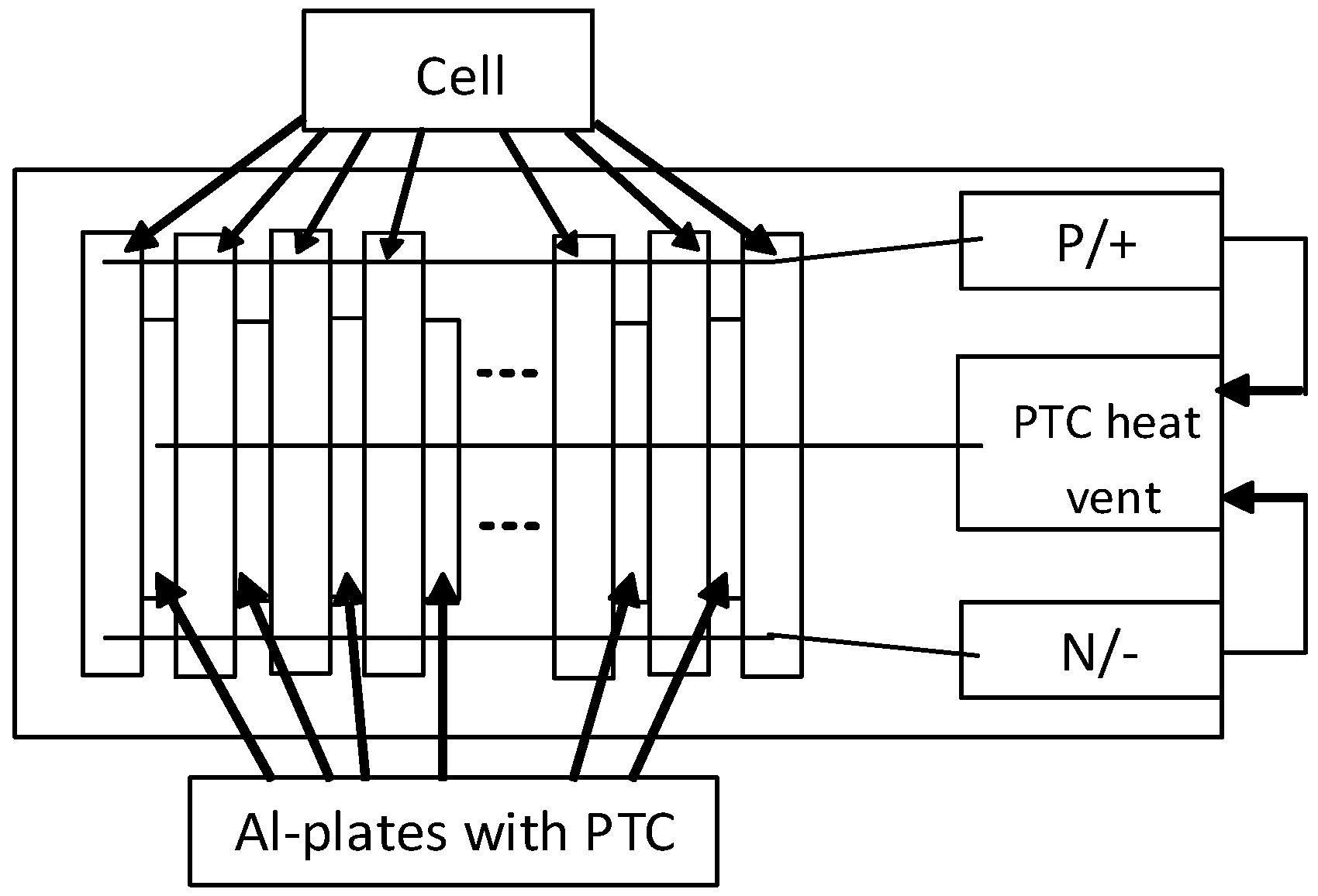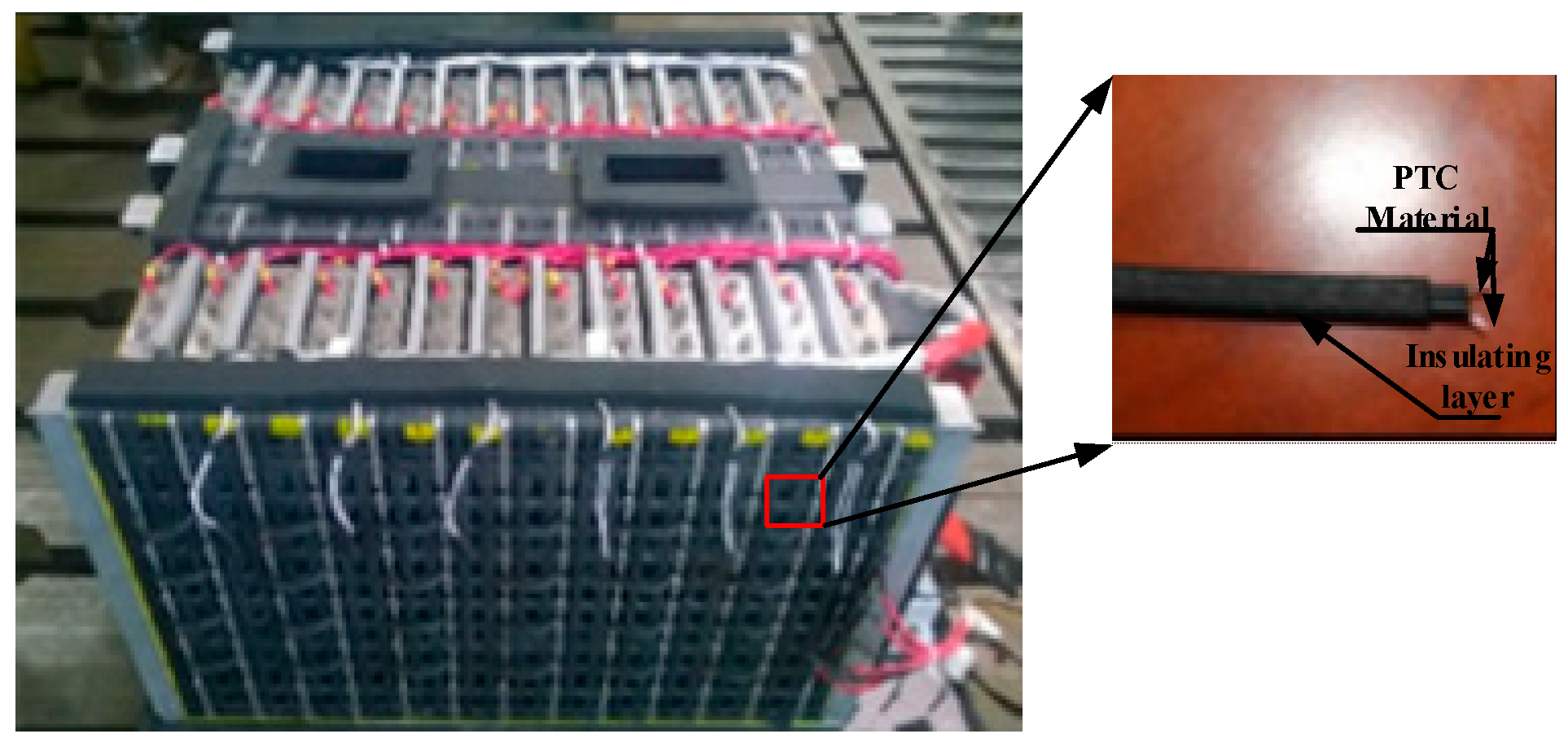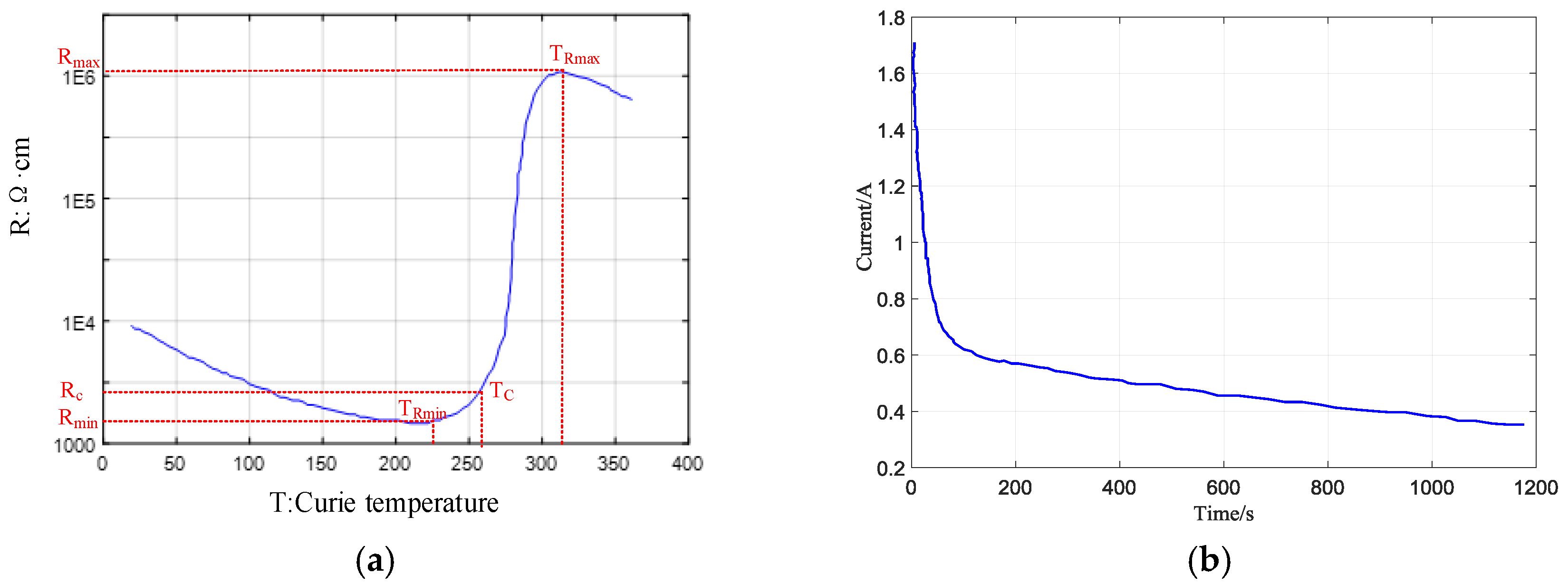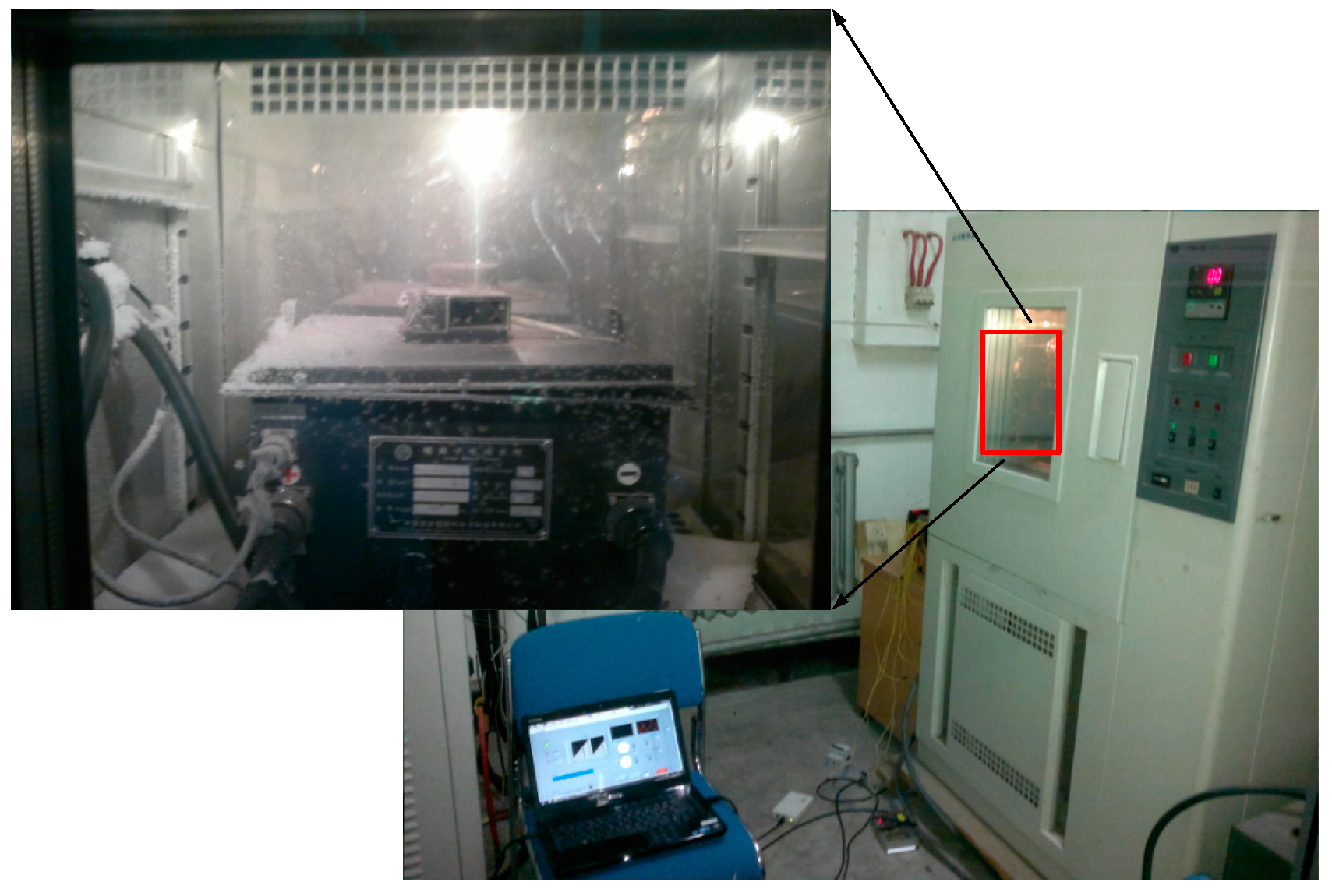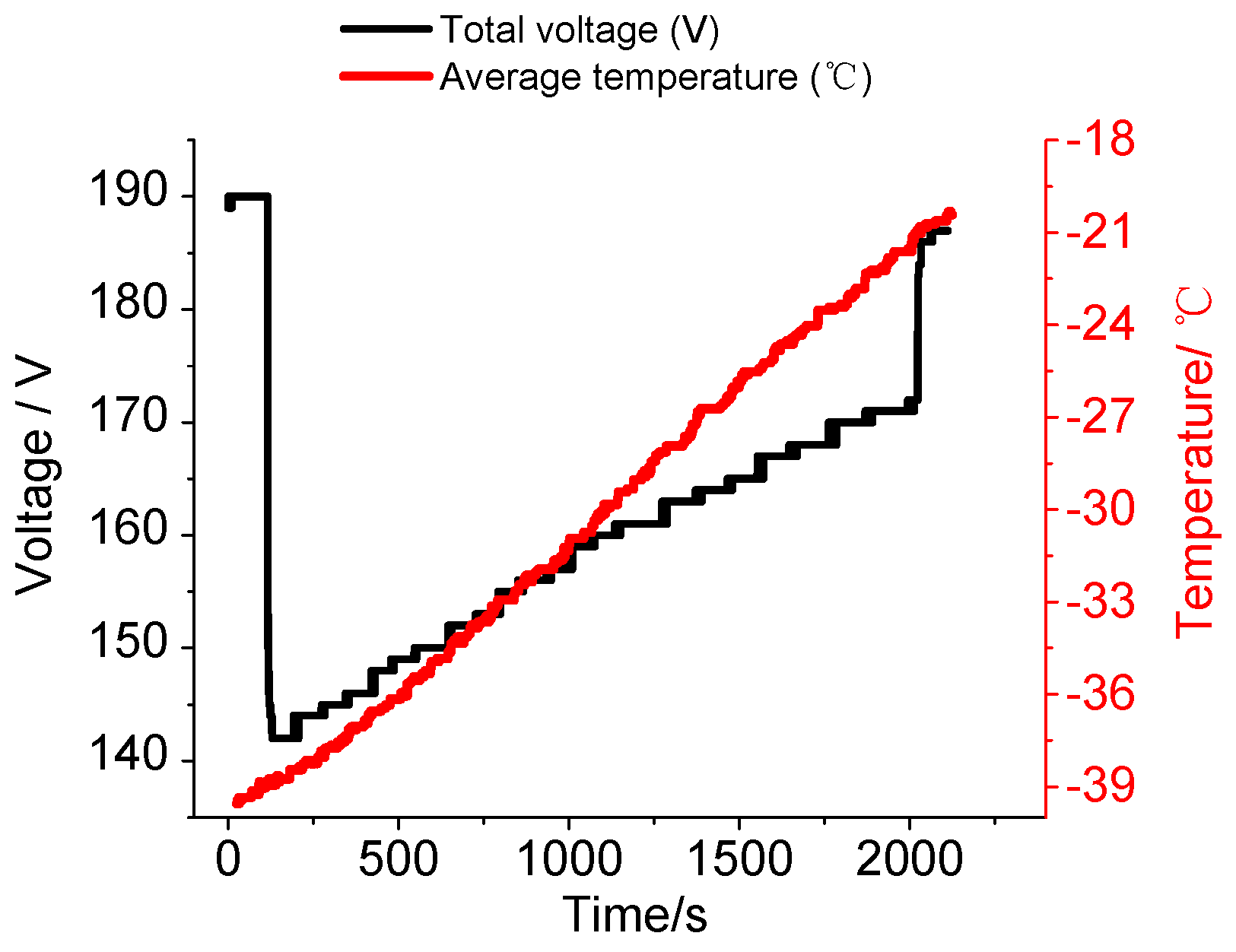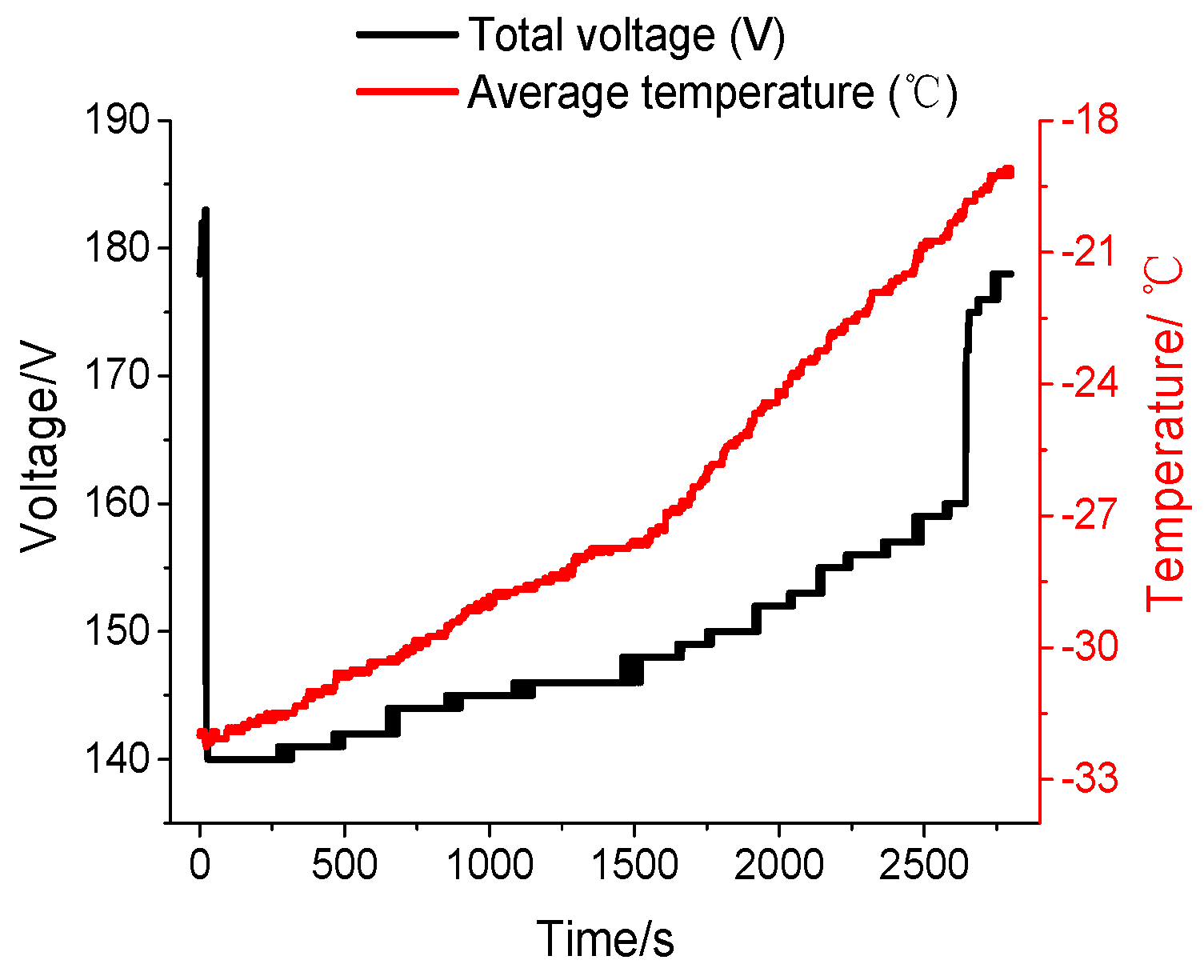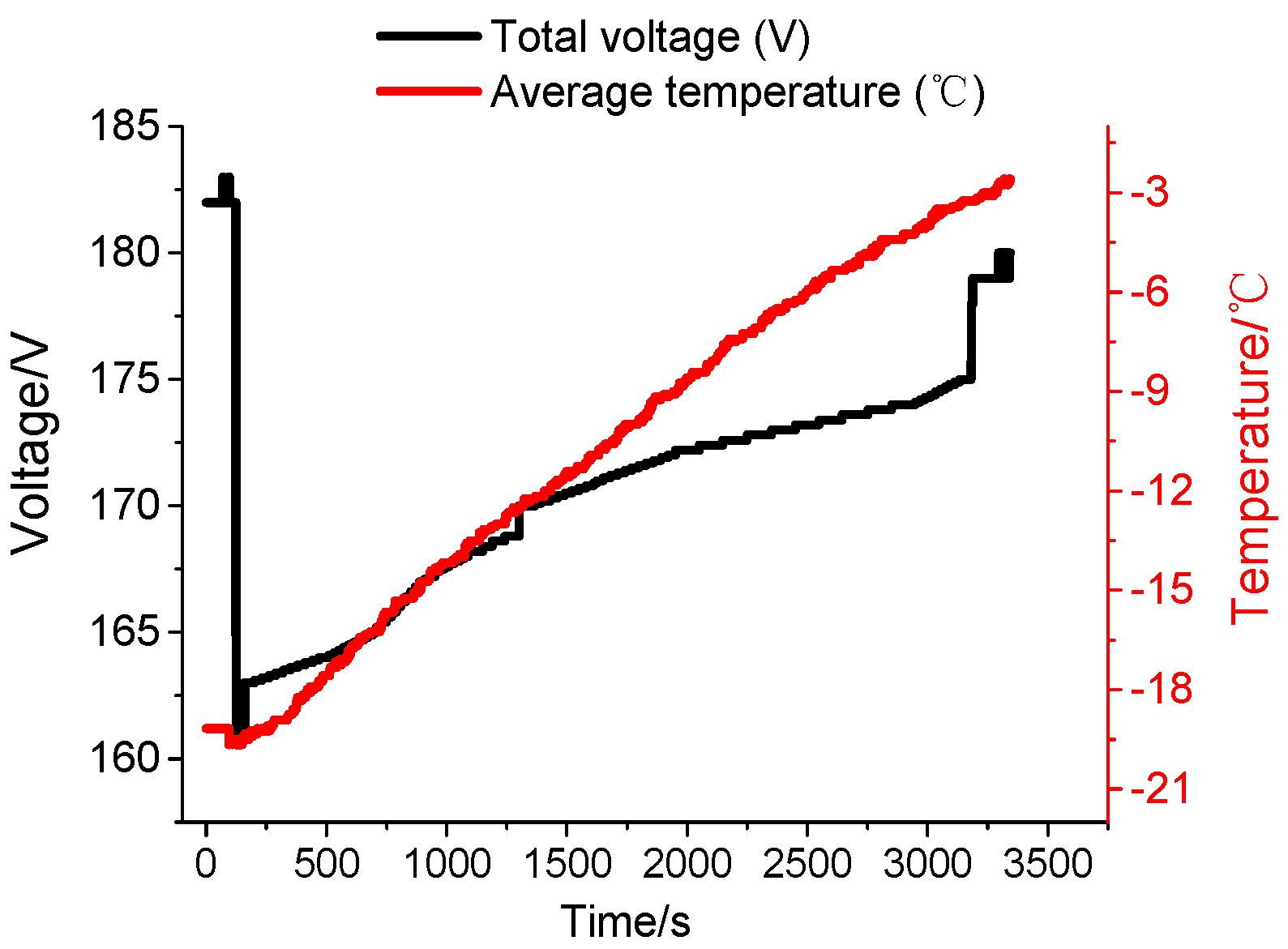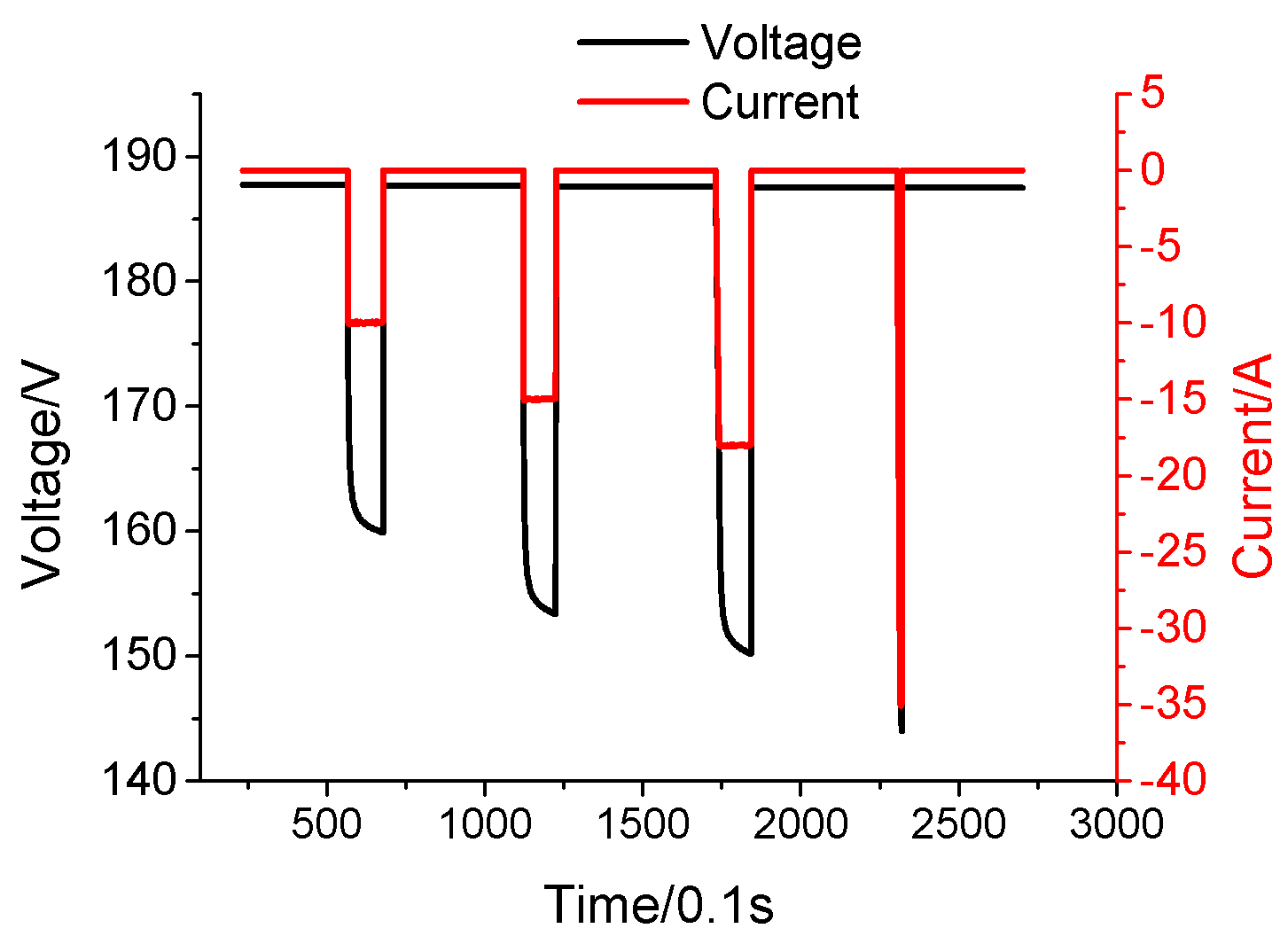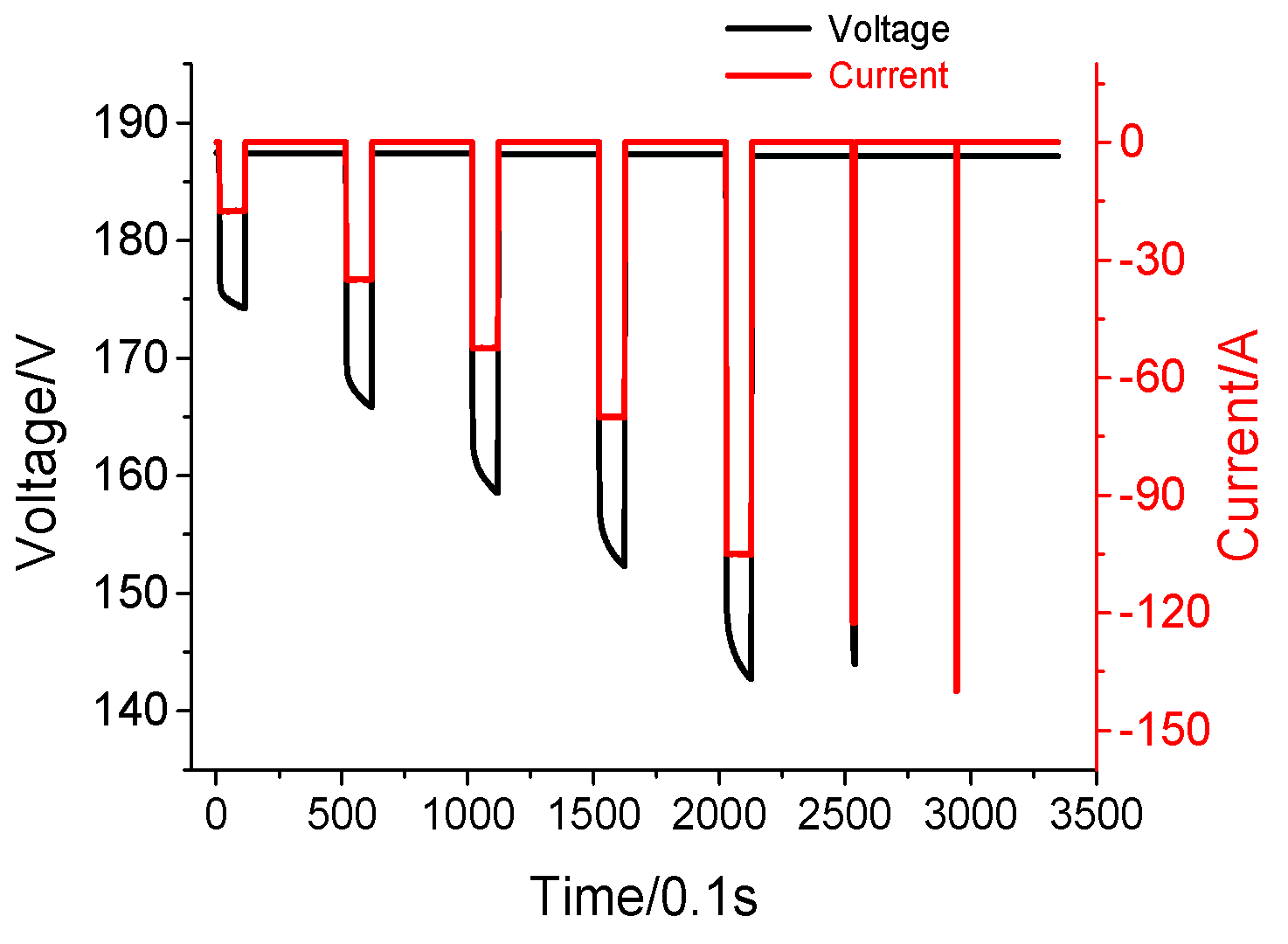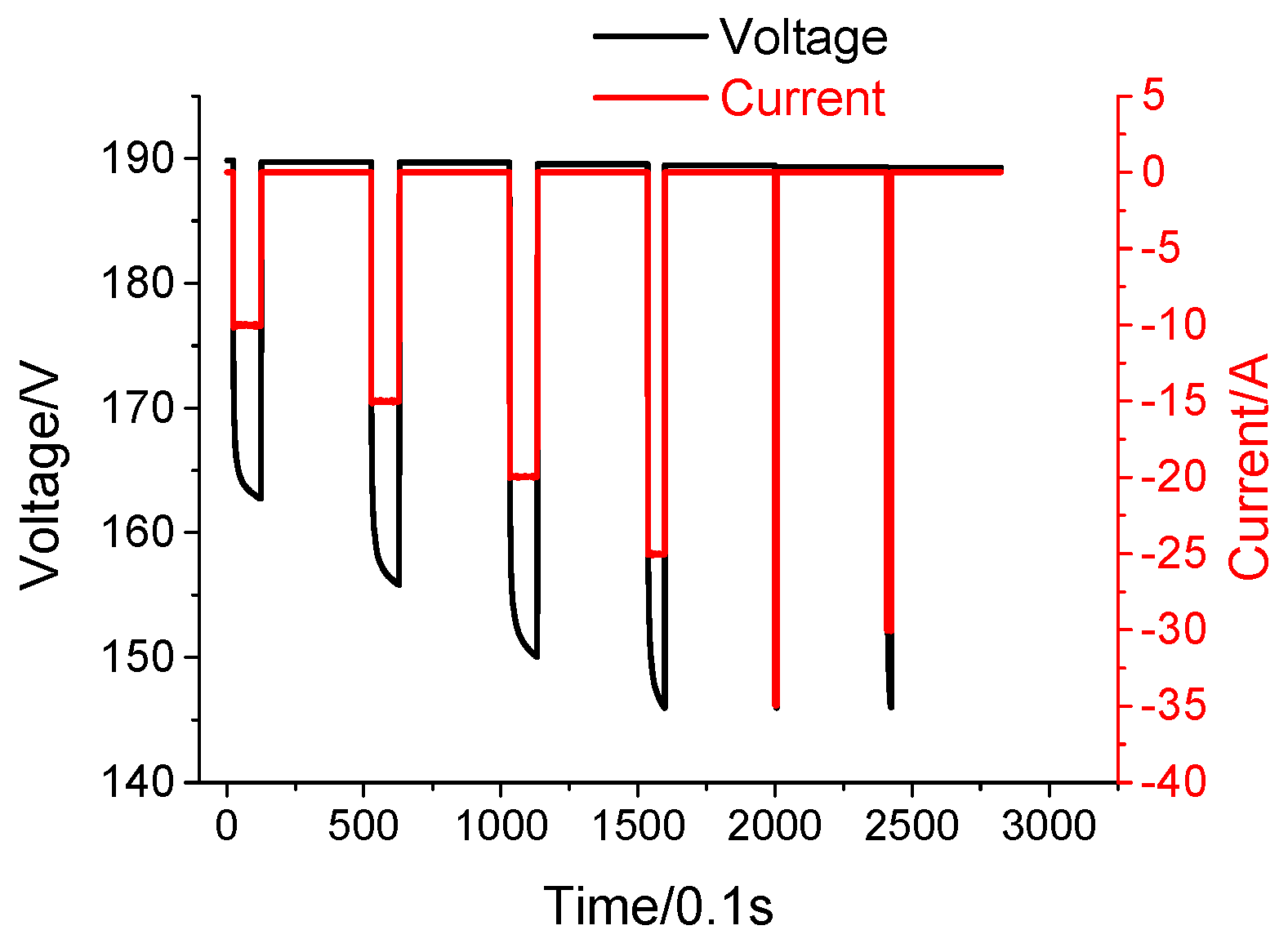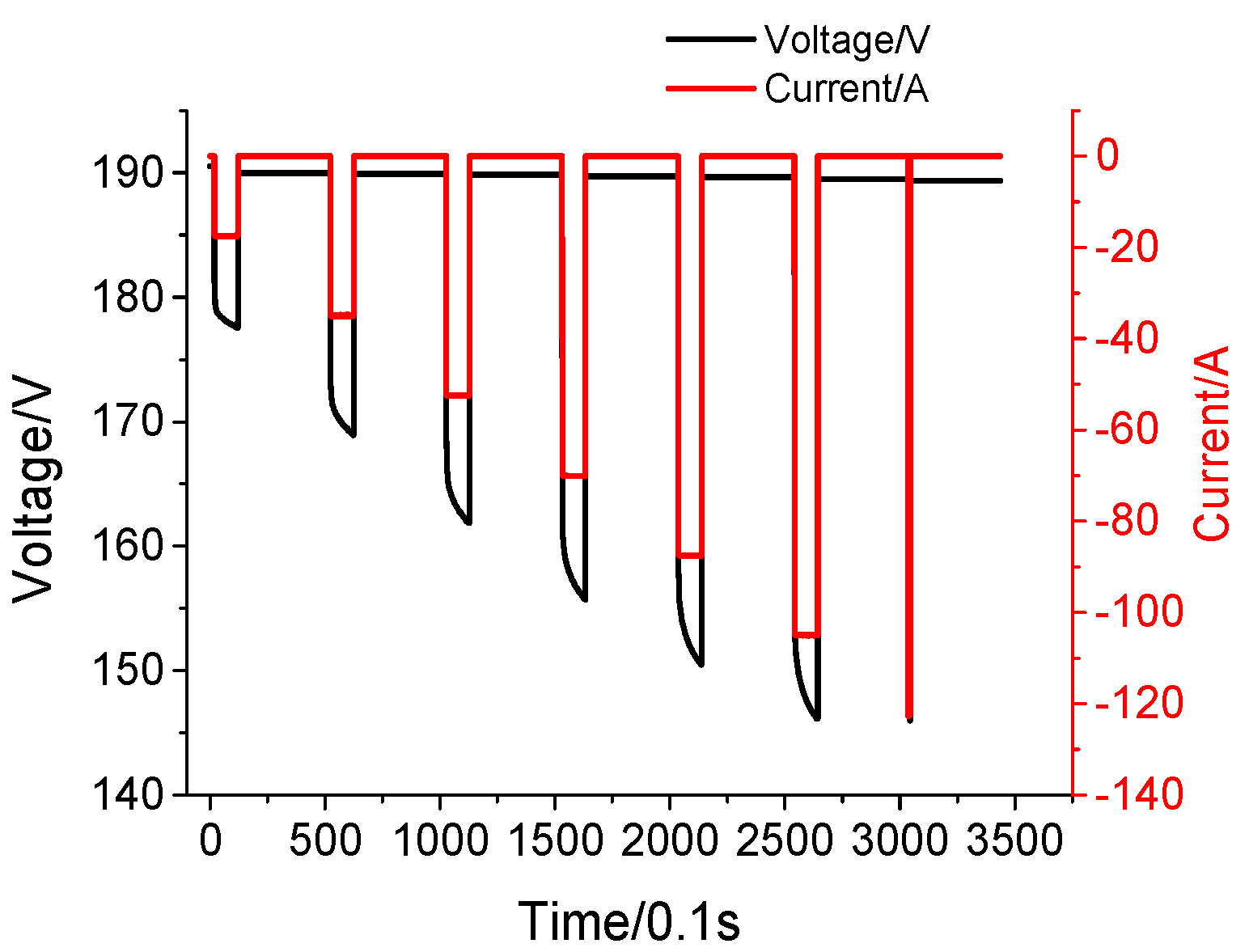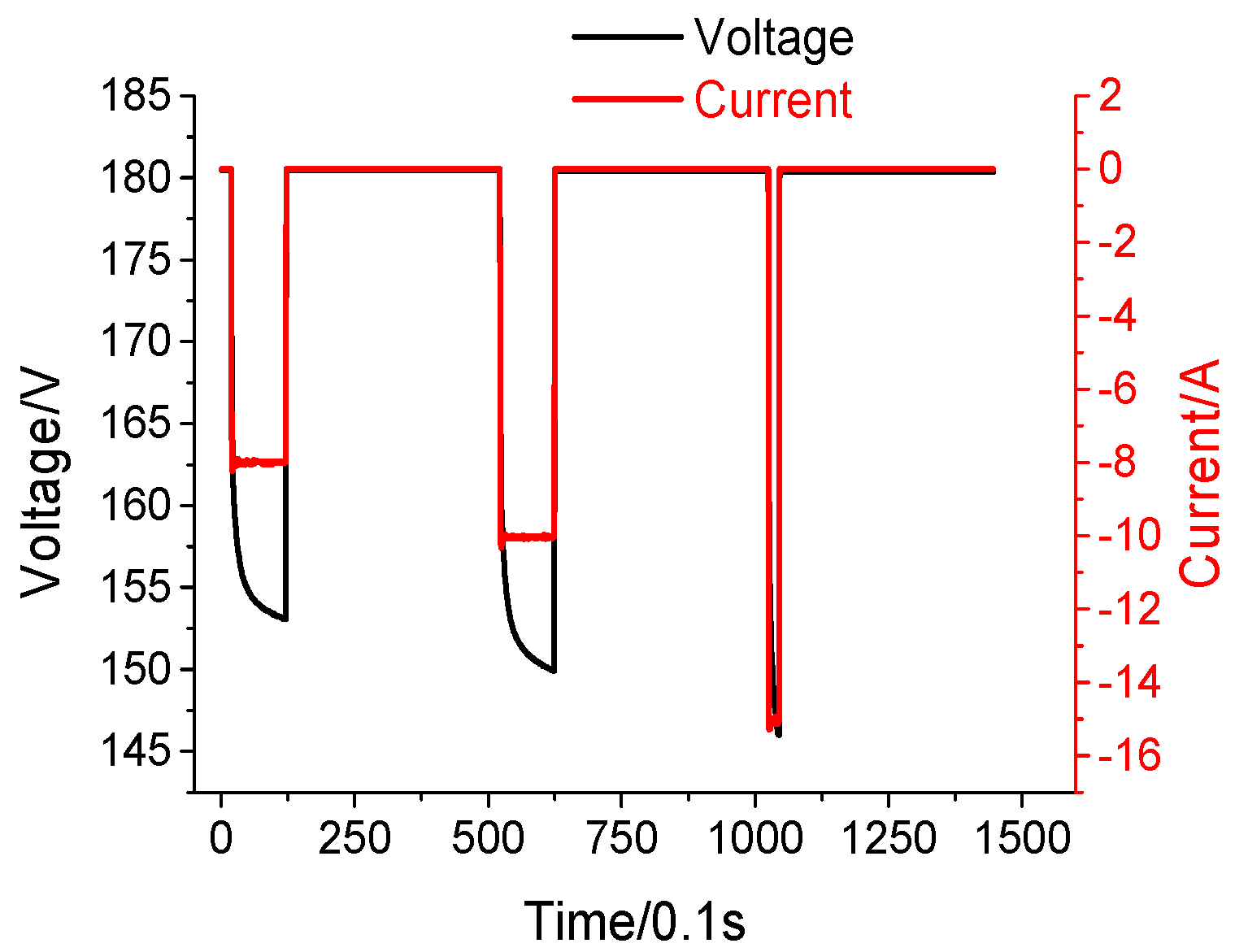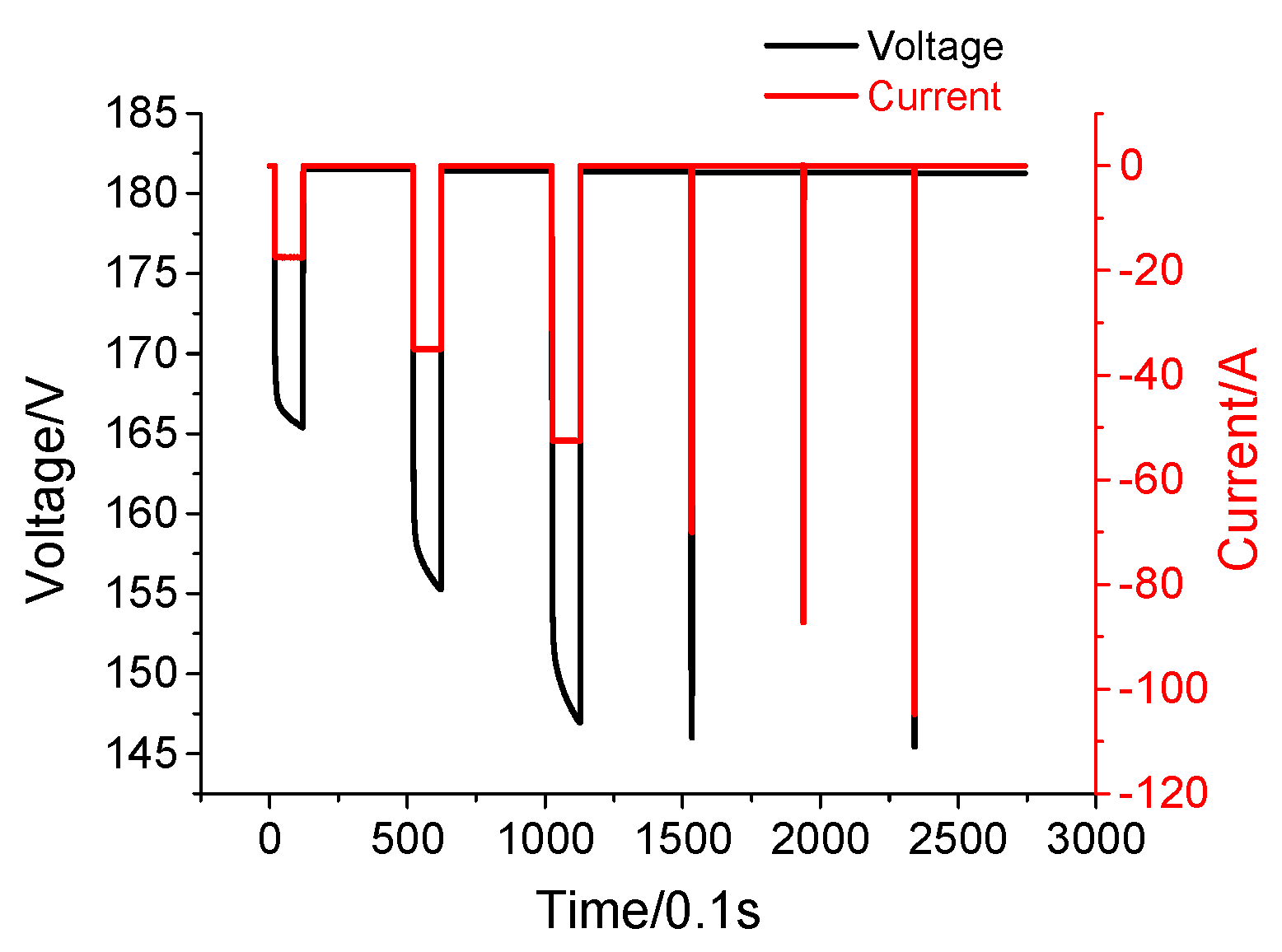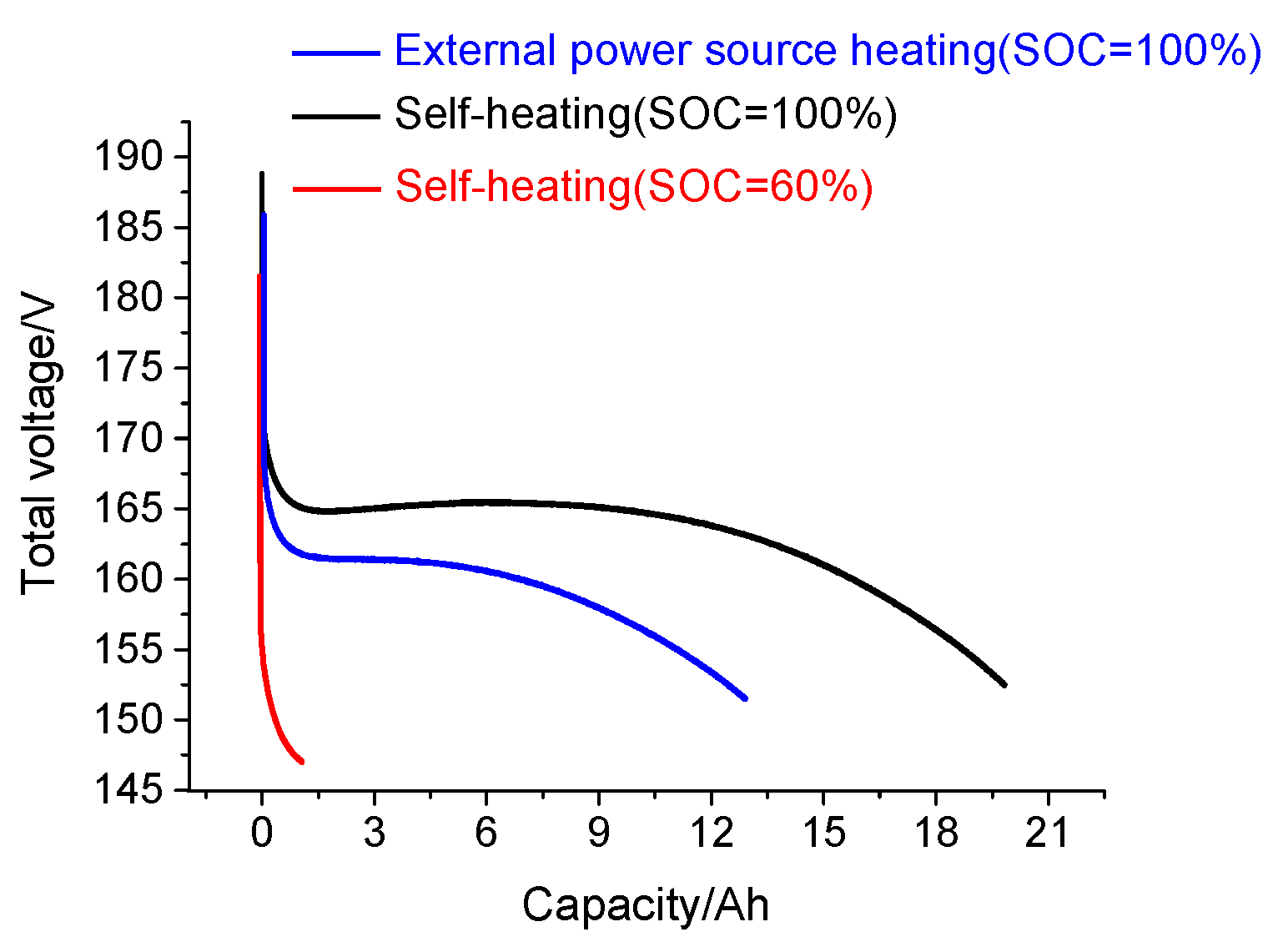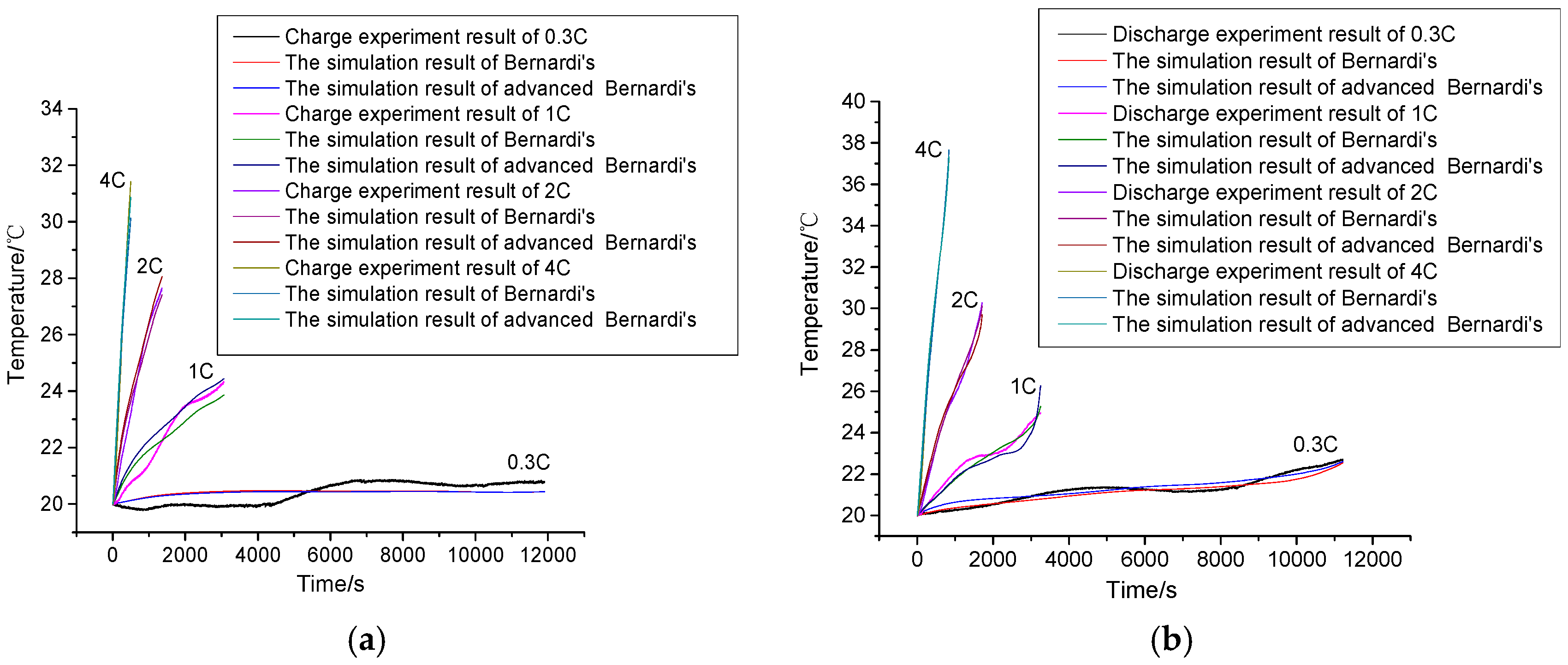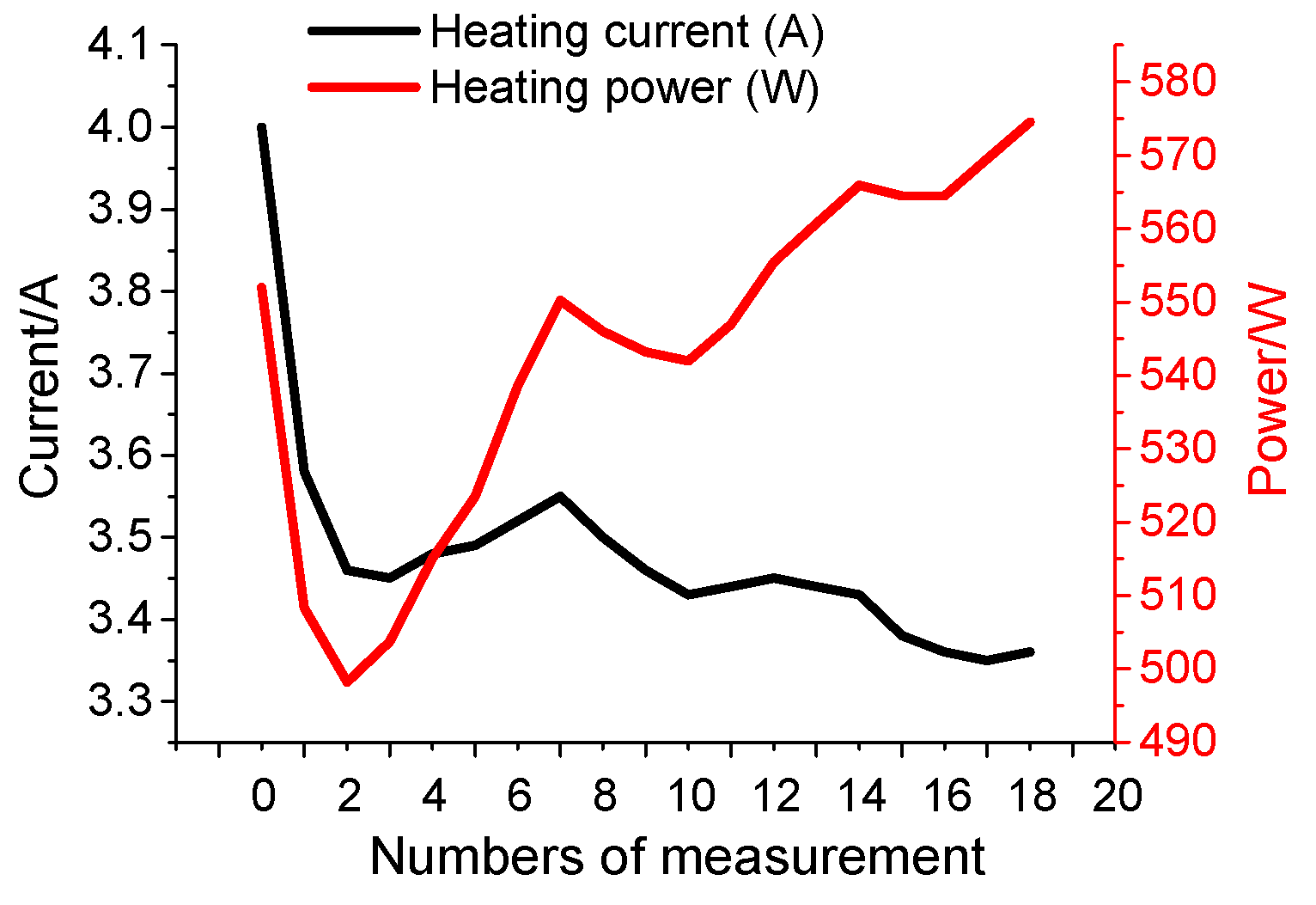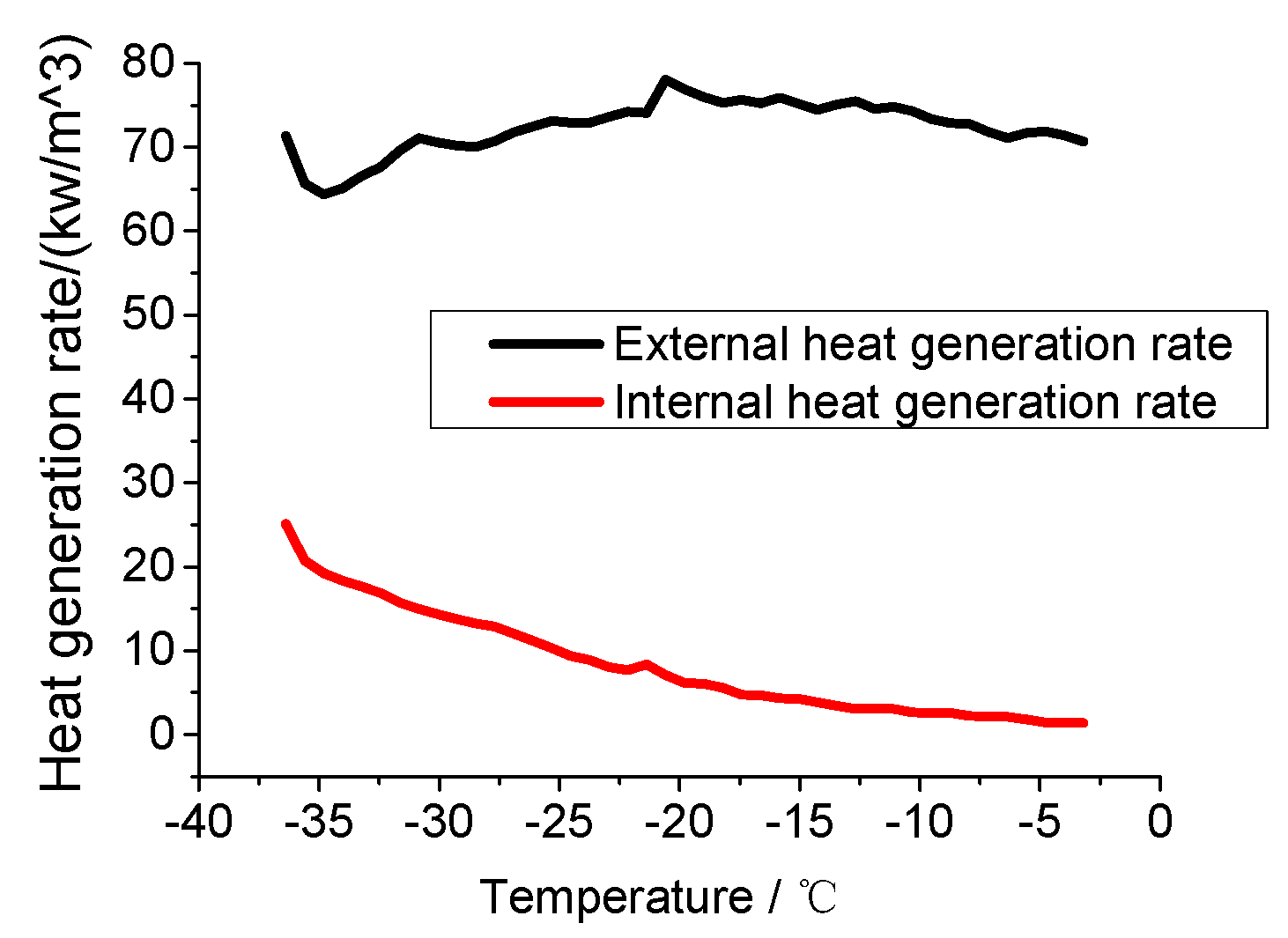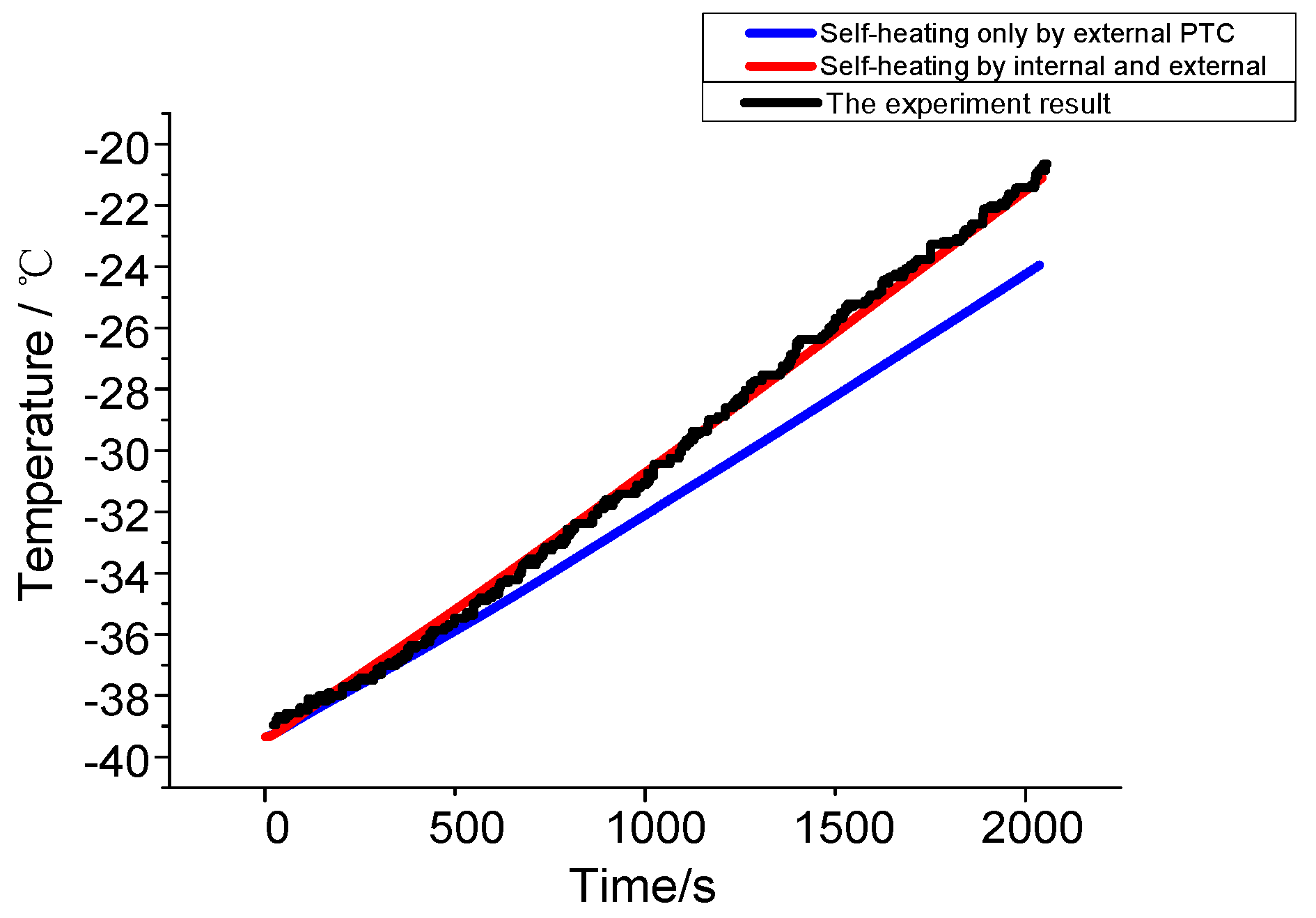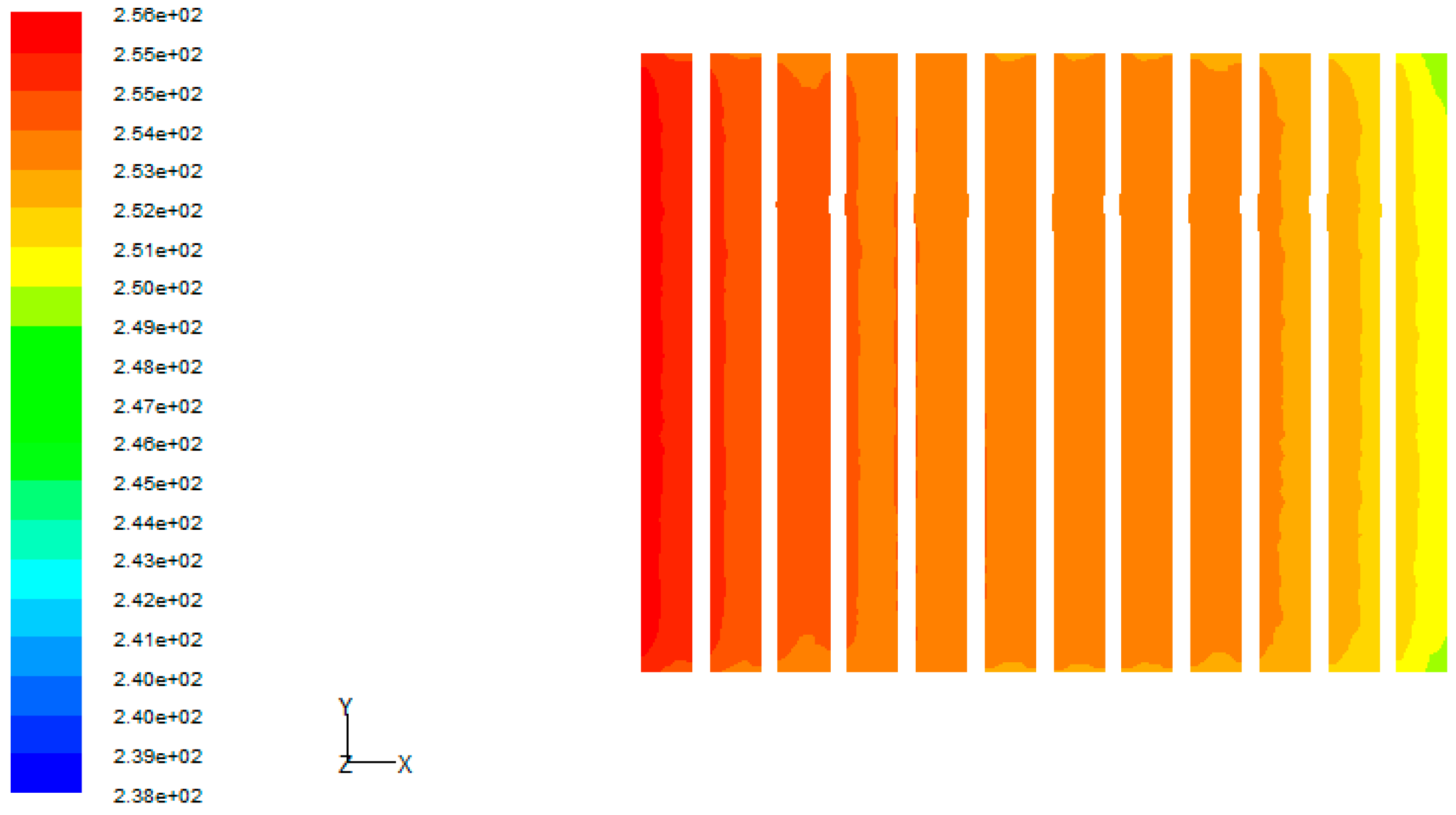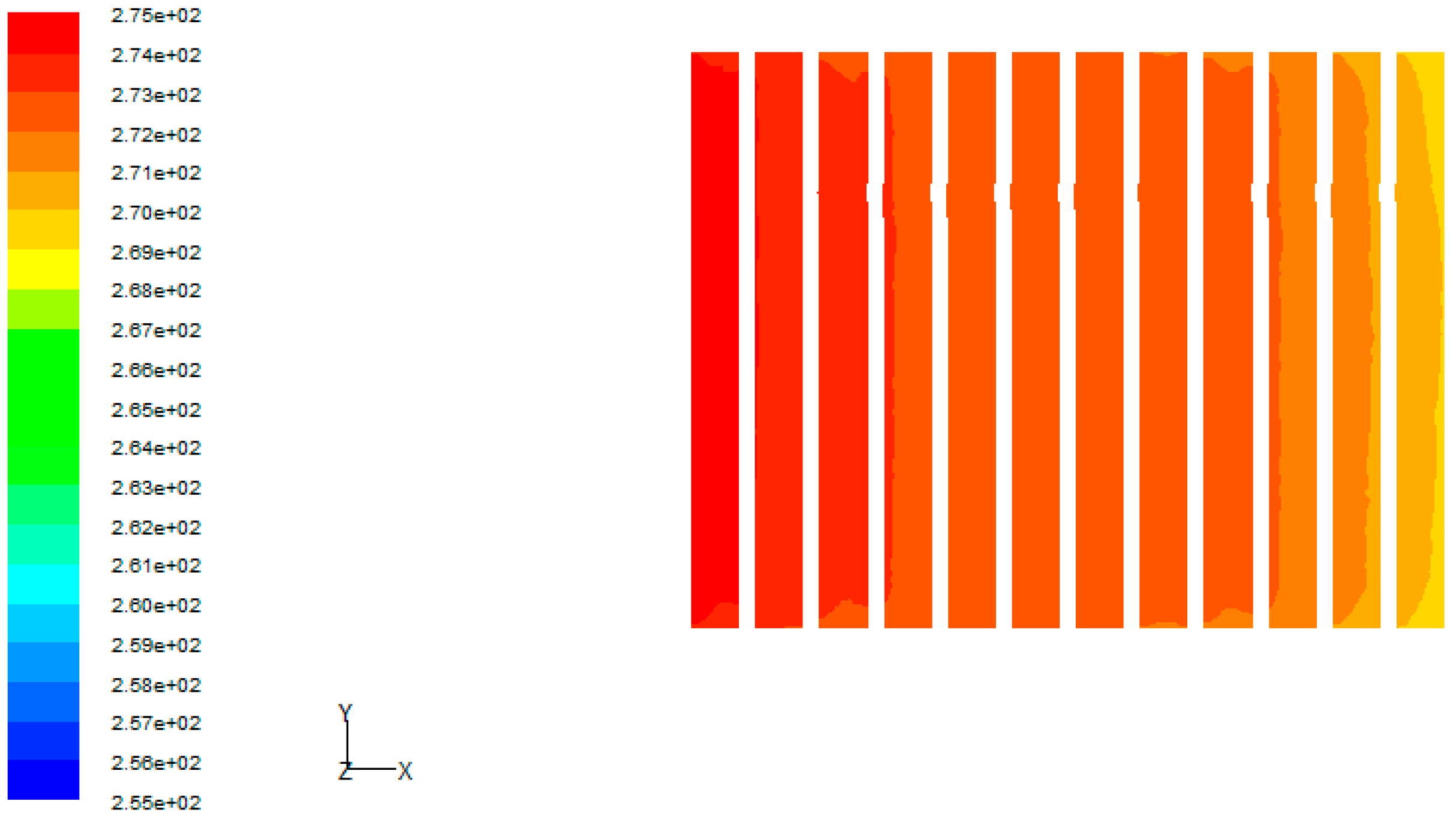1. Introduction
Improving the performance of the Lithium-ion batteries (LIBs) at low temperature has become an urgent problem to be solved, since some problems may exist, such as dramatic decrease of discharge rate and serious degradation of discharge capacity [
1,
2], which may lead to shortened driving range, deteriorated dynamic performance, restricted feasibility and applicability for electric vehicles (EVs) [
3]. One of the relatively feasible methods proved to be effective is heating the LIB pack [
4,
5,
6,
7,
8].
Generally, two types of heating methods for LIB have been adopted: the external heating and the internal heating.
As for the researches on the external heating, Wang et al. [
9] have put forward a battery bottom-heating method with a design of a bench test, and their experimental results verified the bottom-heating method could effectively improve discharge capacity of LIB pack. Based on charge-/discharge performance experiments on the heated cell, Zhang et al. [
10] proved a method of wide-line metal film heating, which could be efficiently applied to enhance cell performances at low temperature. With a low-temperature-heating model for the cell established and a method of electro-thermal-film heater recommended, Cun-shan et al. [
11] confirmed the practical efficacy of their method via simulations and experiments. On the basis of experiments on a convection heat transfer method, in which the battery pack was heated by using heated wires to transfer heat through the air, Wang et al. [
12] found that the surface temperature of the battery pack could be increased from −15 °C to 0 °C after about 21 min of heating.
For the researches on the internal heating methods [
13], Hand and Stuart [
14,
15,
16,
17,
18] have proposed a method with which battery electrolyte be directly heated with Alternating Current(AC). However, they also warned that Direct Current (DC) should not be applied as it might generate a lot of gas inside and thus damage the battery. Zhang J. et al. [
19] pointed out that within a certain scope, the higher the sine AC rose, the lower the frequency might be, and the more rapidly the battery temperature would be increased. Comparing the heat generation process of battery charge and discharge, Zhao et al. [
20] proposed that LIB could be heated at low temperature by combining the large pulse discharge with the small pulse charging.
It can be deduced from the above research that the heating method with external resistance is to heat the battery via heat conduction. The battery heats up rapidly, while the size and weight of the battery pack may be increased. In the heating method with convective heat transfer, there are still some problems such as longer heating time, lower heat exchange efficiency, and poorer temperature uniformity inside the battery pack after heating. Even for a heating method that applies AC to a battery to heat it, problems still exist; for instance, the circuits used in the external heating are complex, and the impact of AC heating on battery life remains to be verified. Moreover, the heating methods discussed above are highly dependent on an external power supply, which will be an inconvenience for EVs. For example, when an external power supply is not available in a cold environment, EVs may not function normally at low temperatures.
To solve the above problems, a positive temperature coefficient (PTC) self-heating method is proposed in this paper. With this method, EVs can be operated independently of external power at low temperature, with the LIB pack being heated on its own when it discharges electricity to provide PTC material power. The main advantages of the method are: (1) Making full use of the PTC heat generation characteristics. Namely, when the temperature is low, and the PTC resistances are small, heating power will be increased. When the temperature rises to a certain extent, the PTC resistances increase sharply, and heating power will be reduced to avoid overheating the LIB pack. (2) Improving heating effects. In a low-temperature environment, as the LIB internal resistances rise, the heat generated by the resistances will also increase, which can be partially transferred directly within the LIB, thus further promoting the heating effects. Based on the PTC self-heating method, three comparative heating experiments, including an external power source heating experiment and two self-heating experiments, were carried out. With further tests on charge/discharge performance implemented, results reveal that the discharge performance of a self-heated battery is better than that of a pack heated by an external power source.
In order to evaluate the heating effectiveness of this method, further study has been conducted to examine temperature distribution uniformity of the heated LIB pack. The heat transfer of the external PTC materials and the internal heat of LIB are analyzed theoretically, and a geometric model is established. The thermal parameters of LIB are obtained, and the heat generation rate of the PTC materials and LIB are calculated with our experimental data. The thermal characteristics of the self-heating process are numerically simulated. With comparison of the simulation results and the experimental results, the accuracy of the modeling and simulation is verified. The results also demonstrate that temperature inside the LIB pack after heating is kept in good uniformity, which proves that this method has the advantage of improving heating effectiveness.
4. Modeling for PTC self-heating
The above experimental results show when the pack at 100% SOC is heated from −40 °C to 0 °C by using the self-heating method and the external power source heating method, its pulse charging/discharging capabilities are equivalent to each other, and yet the 1C CC discharge capacity of the former pack is far greater than that of the latter pack. One possible reason for that result may be that the temperature is not distributed uniformly. Accordingly, a self-heating model is established to further study the temperature distribution uniformity of the pack after heating.
Generally, thermal models for a battery come in a variety of types, such as an electrochemical–thermal coupled model, an electro-thermal coupled model, a thermal abuse model, a 1D model, a 2D model, a 3D model, etc. [
21,
22,
23,
24,
25]. An electrochemical–thermo-coupled model is a battery thermal model established on the basis of the thermo–chemical reaction of the battery, in which the temperature in the battery is considered to be distributed uniformly, with the distribution of current density on the battery pole pieces being ignored. Tiedemann et al. [
26], Pollard and Newman [
27], and Bernardi et al. [
28] have performed many in-depth studies on the electrochemical–thermo-coupled model. The equation of the heat generation rate model proposed by Bernardi, which is one of the most widely used models, will be adopted in this paper.
In this paper, the discussed heat resources generated by heating a LIB pack with self-heating method are derived from two sources: internal heat and external heat. (1) The internal heat refers to the amount of heat produced by the internal resistances, when the LIB is supplying power to the PTC resistance bands; (2) the external heat means the amount of heat produced by the PTC resistance bands. Thus, thermal modeling usually begins with an analysis of the heat generation theories of the internal and external power source.
4.1. Theoretical Analysis of Heat Generation
4.1.1. Theoretical Analysis of the Internal Heat Generation
The internal heat generation of the LIB is the internal heat source of the thermal model, so the calculation accuracy of heat generation directly influences the accuracy of the thermal model. As the assumption of Bernardi heat generation model is not consistent with the actual temperature distribution in the LIB, some researchers have made improvements in the Bernardi heat generation model based on the introduction of the current density.
- (1)
The Bernardi heat generation rate model.
The equation for Bernardi’s heat generation rate model is as follows [
28]:
where
denotes the heat generation rate, the unit is W;
denotes the charge/discharge current, the unit is A, and in the charging process,
has a negative value, while in the discharging process,
has a positive value;
T denotes the temperature, the unit is K, and the average temperature is adopted when calculating
;
denotes the change rate of open circuit voltage with the temperature; Joule heat and reaction heat are mainly considered in
. In Equation (1),
denotes joule heat, and
denotes reaction heat.
- (2)
The advanced Bernardi heat generation rate model.
The equation for the advanced Bernardi heat generation rate model is as follows:
where
denotes the charge/discharge current density of the positive/negative plate.
According to the LIB temperature variation during the charging/discharging process at different currents, the accuracies of the two models are compared and the results are shown in
Figure 17.
It can be seen from
Figure 17 that the calculation accuracy of the advanced Bernardi heat generation model is not superior to that of the initial one, and the advanced model is also highly computationally demanding, which is not conducive to calculations for the heating model of the LIB pack. Therefore, this paper adopts the Bernardi heat generation model.
4.1.2. Analysis of Internal Heat Conduction
Before establishing the model, we initially set up a differential equation of heat conduction for a LIB cell, which will help us to understand at the microscopic level the heat generation, heat transfer, and temperature rise inside the cell.
Also before establishing the thermal differential equation, we put forward some assumptions: (1) The inner part of a cell composed of different materials should be simplified into an isotropic continuous medium; (2) if heat is generated inside a cell, the internal heat should be uniformly distributed.
Next, we assume that a micro-unit will be taken out from a cell; as shown in
Figure 18,
,
,
represent the heat fluxes flowing respectively into the micro-unit from its left side, from below, and from the back, respectively;
,
,
stand for the heat fluxes flowing out of the micro-unit from the right side, from the top, and from the front, respectively. According to Fourier’s law, Equation (3) can be obtained:
Here, the internal instantaneous heat power of the micro-unit is . If there is no internal heat source in a micro-unit, then ; and the thermodynamic increment of a micro-unit is , where denotes the heat power per unit volume; denotes the density; denotes the specific heat capacity; denotes the temperature; and denotes the time.
According to the conservation of energy, a general expression of the heat conduction differential equation in the rectangular coordinate system can be obtained:
4.1.3. Analysis of the External Heat Conduction
As the heat generated externally is originated primarily from the PTC material, this paper analyzes the external heat transfer, with two aspects considered—heat conduction and heat convection—and with the radiation heat transfer being ignored.
The theoretical basis of heat transfer is Fourier’s law, which can be expressed as: the heat flux at any point and any time is proportional to the temperature gradient at that point. The formula is as follows:
where
denotes the heat flux density of heat conduction;
denotes the coefficient of heat conductivity; and
denotes the direction of the outer normal. Since the heat is transferred from the points of high temperature to those of low temperature, the resulting value in Equation (5) is negative.
As the sides of the cells are heated directly by the aluminum plates arranged between the sides of every two cells, the other sides of the cells can only be heated by the heated air flow, which can be calculated by using the Newton cooling formula:
where
denotes the heat transfer coefficient and the unit is W/(m
2·K).
4.1.4. Heat Generation and Conduction Model
Combining the heat conduction differential equation and the Bernardi heat generation rate model, the heat generation and conduction model can be obtained:
where
is the correction coefficient of the heat generation rate.
The initial and boundary conditions are as follows:
4.2. The Establishment of a Geometric Model
Several assumptions are made to simplify the geometry model of the pack. (1) As the thickness of each element inside the LIB is very small, the amount of calculation work will become considerable if the three-dimensional model is established with every element. Therefore, the cell composed of different materials is simplified into an isotropic continuous medium. (2) The PTC heat generation rate is assumed to be equivalent to the heat generation rate of aluminum plates; because the thermal conductivity of aluminum plates is relatively larger and the PTC resistance bands are embedded in the aluminum-plate containers, the heat produced by the PTC material can be rapidly transferred to the aluminum plates. (3) The connectors, wires, and insulation objects inside the pack are ignored, and the irregular structures of the pack are assumed to be regular cuboids. All the above assumptions can help simplify the model and shorten the calculation. (4) Based on the symmetry principle, the 48 s battery pack can be reduced to a 1/4 model composed of 12 cells. Simulations of the temperature field of the whole LIB pack can thus be simulated with boundary conditions.
Based on the above simplifications, the 1/4 geometry model falls into four aspects: (1) 12 cells; (2) 12 aluminum plates, including an aluminum plate at the center of the original 48s pack; (3) the LIB pack shell; and (4) the air flow inside the pack. Relevant parameters for modeling are listed in
Table 6 and a geometric model is shown in
Figure 19.
4.3. Acquisition of Model Parameters
4.3.1. Acquisition of the Thermo-Physical Parameters
The general thermo-physical parameters of each components inside LiMn
2O
4 cell are as shown in
Table 7.
Yet, some thermo-physical parameters still need to be calculated, such as: density, specific heat capacity, heat conductivity coefficient, etc.
- (1)
The cell density can be calculated by using the mean method, and the general formula is:
where
M is the total quality of the cell, and
V the total volume of the cell.
- (2)
The specific heat capacity of the cell can be calculated by using the theoretical equation expressed as Equation (10):
- (3)
The heat conductivity coefficient of the cell can be calculated by using the thermal resistance method, which leads to Equations (11) and (12):
where
is the thickness of the cell; and
,
,
,
and
,
,
,
denote the lengths and the heat conductivity coefficients of cathode plates and anode plates, separator, and shell, respectively.
Based on Equations (9)–(12), the calculated results are: density 2182.7 kg/m3; specific heat capacity 1100 J/(K·kg); and heat conductivity coefficient 0.895 W/(m·K).
4.3.2. Internal and External Heat Generation Rates
The discharge voltage and current in the heating processes are acquired with self-heating experiments. The calculation approach discussed in
Section 4.1 is used to determine the internal and external heat generation rate. The heat generation rates are obtained many times to fully demonstrate the real-time changes in heating, so the simulation may be kept closer to the actual experiment. Graphs of the heating current and power during the first and second heating experiments are shown in
Figure 20 and
Figure 21, respectively.
- (1)
In the first self-heating process, the heating current tends to decrease, while the heating power keeps increasing. The reasons may be that the PTC material resistances increase as the temperature rises; at the same time, the pack voltage platform is also being raised, and the degree of resistance increase is greater than that of the voltage rise.
- (2)
In the second self-heating process, although the temperature is still rising, the battery voltage platform has been basically stabilized. At this time, as the PTC material resistances increase dramatically, the heating current will decrease and the heating power is gradually reduced.
With the calculation results of the internal and external heat generation rate, we can acquire a graph of the heat generation rate for the pack from −40 °C to 0 °C. As shown in
Figure 22, the mean value of the external heat generation rate is 72.386 kw/m
3, and the mean value of the internal heat generation rate is 8.337 kw/m
3, which is about 11.5% of the former.
5. Results and discussion
We write the program according to the results in
Figure 22 and import the geometric model in to our simulation design, then conduct a numerical simulation.
Although the heat generation rate inside the battery is rather small, it cannot be ignored because of its direct effect on the battery. In order to better verify the characteristics of the internal heat generation, two cases are also included in the simulation:
- (1)
Considering the co-generation of both the internal and the external heat in the heating process, which is in line with the actual situation.
- (2)
Ignoring the internal heat, with only the external heat considered.
The curves of temperature rise, acquired from experiments and simulations on the battery during two heating processes, are shown in
Figure 23 and
Figure 24, respectively.
As shown in
Figure 23 and
Figure 24, simulation curves of the internal and external co-heating are in good agreement with the temperature rise curves obtained during the experiments. The average and maximum temperature difference in the first heating process are 0.201 °C and 0.938 °C, respectively. The average and maximum temperature difference in the second heating process are 0.164 °C and 0.783 °C, respectively. The above results verify the accuracy of the simulation results. The simulation curve, without regard for the internal heat, is significantly lower than the curve in the experimental process, which fully illustrates the significance of internal heat on the LIB temperature rise. Even if the heat rate is comparatively tiny, it should not be ignored.
Next, utilizing the function of temperature contour, we further analyze the temperature distribution inside the pack after heating. The results are shown in
Figure 25 and
Figure 26.
As can be seen from
Figure 25, for the cell on the far left, namely in the middle of the original 48-s battery pack, it is raised to the highest temperature of −18.8 °C after heating; for the cell on the far right, namely close to the pack container shell, the lowest temperature only reaches −23.47 °C after heating. The maximum temperature difference inside the pack amounts to 4.67 °C. Similarly, as can be seen in
Figure 26, the highest and lowest temperatures within the pack after heating are 0.248 °C and −3.258 °C, respectively, with a maximum temperature difference of 3.506 °C.
Although the quantity of heat generation for each cell is virtually identical, the temperature of the cell on the far left is the highest and the temperature of the cell on the far right is the lowest. The reason may be that the position of the cell on the far left is at the center of the original 48-s pack, and the heat convection is slow, as a result, it is kept at the highest temperature and vice versa, as the cell on the far right is placed next to the outer shell of the pack and the heat convection is rapid, it is maintained at the lowest temperature. The temperature difference after the second heating is smaller than that of the first heating, which may be explained by the fact that with the extension of heating time, the heat generated inside the battery is more favorable for the uniform temperature distribution.

